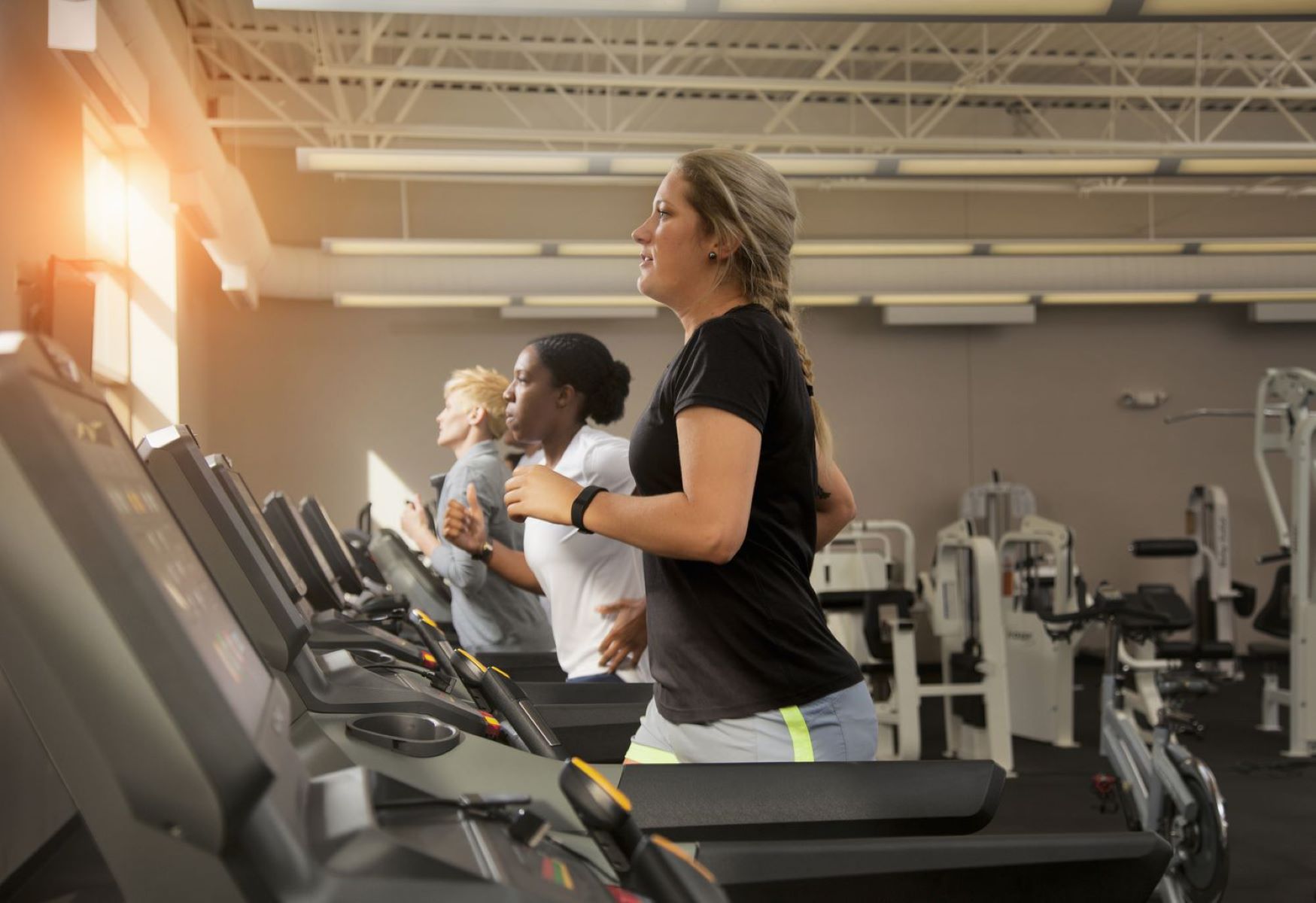

Featured
How To Train For A 5K Run
Modified: January 22, 2024
Featured guide on how to train effectively for a 5K run, including expert tips, workout routines, and nutrition advice. Boost your running performance and achieve your fitness goals!
Introduction
Welcome to the exciting world of 5K running! Whether you are a seasoned athlete looking for a new challenge or a beginner wanting to improve your fitness level, the 5K distance is a perfect starting point. A 5K race covers a distance of 5 kilometers, which is equivalent to approximately 3.1 miles. It is a popular race distance for runners of all ages and abilities.
Training for a 5K requires commitment, determination, and a well-rounded approach. In this article, we will guide you through the essential steps to train effectively and prepare for a successful 5K run.
Before embarking on your training journey, it is important to set clear goals. Are you looking to complete your first 5K race, improve your personal best time, or simply enjoy the experience? Defining your goals will help you tailor your training program and keep you motivated throughout the process.
Creating a structured training schedule is crucial for progress and injury prevention. Consistency is key, so aim to run three to five times per week, depending on your fitness level and availability. Ideally, your plan should include a mix of easy runs, long runs, speed training, and strength training.
Choosing the right running gear is essential to ensure comfort and prevent injuries. Invest in a good pair of running shoes that provide proper support and cushioning for your feet. Additionally, consider moisture-wicking clothing to keep you cool and dry during your runs.
Prior to each run, warm up with dynamic stretches to increase blood flow to your muscles and prevent injury. After your run, cool down with static stretches to aid in recovery and reduce muscle soreness.
Maintaining proper running form is crucial for efficiency and injury prevention. Focus on running with a relaxed posture, engaging your core muscles, and keeping a steady rhythm. Avoid overstriding and aim for a midfoot strike.
Building endurance is a critical component of 5K training. Gradually increase your mileage each week, allowing your body time to adapt. The long run is a key workout in building endurance, so gradually increase your distance over time.
Speed and interval training can improve your race pace and increase your overall speed. Incorporate workouts such as tempo runs, fartleks, and interval training into your training schedule to build speed and improve your cardiovascular fitness.
In addition to running, incorporating strength training exercises into your routine can help improve your running performance and prevent injuries. Focus on exercises that target your lower body, core, and upper body strength.
Cross-training activities such as cycling, swimming, or yoga can complement your running training and provide variety. They help to improve overall fitness, prevent burnout, and reduce the risk of overuse injuries.
Setting Your Goals
Before you begin your 5K training journey, it’s important to set clear and attainable goals. Setting goals not only provides you with a sense of purpose and direction, but it also helps you stay motivated and focused throughout your training.
When setting your goals, consider what you want to achieve with your 5K race. Are you aiming to complete your first 5K, improve your previous time, or perhaps place within your age group? Your goals are personal, so take some time to reflect on what you want to accomplish.
It’s important to set both short-term and long-term goals. Short-term goals can be achieved within a few weeks or months and help you stay motivated along your training journey. Long-term goals, on the other hand, are the bigger picture targets that you aim to achieve over a longer period of time.
Ensure that your goals are specific, measurable, attainable, relevant, and time-bound (SMART). For example, instead of setting a vague goal like “I want to run a 5K”, make it more specific and measurable, such as “I want to complete a 5K race in under 30 minutes within the next three months”. This gives you a clear target to work towards and allows you to track your progress.
While it’s important to set challenging goals, it’s also crucial to be realistic and consider your current fitness level, time availability, and any potential constraints. Pushing yourself too hard or setting unrealistic goals can lead to burnout or potential injury. Start with smaller milestones and gradually work your way up as you progress in your training.
Another factor to consider when setting your goals is the intrinsic and extrinsic motivation behind them. Intrinsic motivation refers to the internal rewards and enjoyment you get from running and achieving your goals, such as the sense of accomplishment or the joy of improving your fitness. Extrinsic motivation, on the other hand, refers to external rewards or incentives, such as participating in a charity race or running with friends. Understanding what motivates you can help you stay focused and committed to your goals.
Write down your goals and keep them somewhere visible, like on your refrigerator or as your phone wallpaper. This constant reminder will help you stay focused and accountable to your training plan.
Remember, setting goals is not just about the finish line, but also about enjoying the journey and embracing the process. Celebrate your small victories along the way and don’t forget to have fun!
Creating a Training Schedule
Creating a well-structured training schedule is integral to your success in preparing for a 5K run. A training schedule provides you with a roadmap, ensuring that you gradually build your fitness and avoid overtraining or injuries. Here are some key steps to consider when creating your training schedule:
Assess Your Current Fitness Level: Before diving into a training plan, it’s essential to assess your current fitness level. This will help you determine your starting point and customize your training program accordingly. If you’re a beginner, start with a run-walk program and gradually increase the amount of running each week.
Set Your Race Date: Determine the date of your 5K race and work backward to create a training schedule. Ideally, give yourself at least 8-12 weeks to train, depending on your current fitness level and goals.
Plan Your Training Days: Aim to run 3-5 times per week, depending on your fitness level and availability. Incorporate a mix of easy runs, long runs, speed workouts, and rest days to allow your body time to recover and adapt to the training load.
Gradual Progression: Gradually increase your mileage and intensity each week to avoid overuse injuries. The 10% rule is a good guideline to follow – increase your weekly mileage by no more than 10% compared to the previous week.
Listen to Your Body: Pay attention to any signs of fatigue or pain. If you’re feeling excessively tired or experiencing discomfort, it’s important to prioritize rest and recovery. Pushing through pain can lead to injuries and setbacks in your training.
Flexibility: Be flexible with your training schedule. Life happens, and there may be times when you need to adjust your training days or mileage. It’s okay to deviate from the plan occasionally as long as you maintain consistency and stay committed to your overall training goals.
Variety in Workouts: Include a mix of different types of runs in your training schedule. Include easy runs to build aerobic endurance, long runs to increase stamina, speed workouts to improve your race pace, and rest days for recovery. Be sure to incorporate cross-training activities such as cycling or swimming to give your body a break from running and work different muscle groups.
Track Your Progress: Keep a training log to record your workouts, mileage, and how you felt during each run. This will not only help you monitor your progress but also allow you to identify patterns or areas for improvement.
Seek Professional Guidance: If you’re a beginner or have specific goals in mind, consider seeking guidance from a running coach or certified personal trainer. They can help create a personalized training plan tailored to your needs and ensure you’re progressing safely and effectively.
Remember, a training schedule is a guide, but listen to your body and make adjustments as needed. Prioritize rest and recovery, and don’t forget to enjoy the process of preparing for your 5K run!
Choosing the Right Running Gear
When it comes to running, choosing the right gear is crucial for comfort, performance, and injury prevention. Here are some key factors to consider when selecting your running gear:
Running Shoes: Investing in a good pair of running shoes is essential. Visit a specialty running store where experts can analyze your running gait and recommend shoes that provide the right amount of support and cushioning for your feet. Consider factors such as arch type, pronation, and the terrain you’ll be running on.
Appropriate Clothing: Opt for moisture-wicking and breathable clothing to keep you dry and comfortable during your runs. Avoid cotton materials as they tend to retain moisture and can lead to chafing and discomfort. Dress in layers for varying weather conditions and don’t forget to wear reflective gear if running in low-light conditions.
Socks: Invest in good-quality running socks that reduce friction and provide padding and support. Look for socks made from moisture-wicking materials to keep your feet dry and prevent blisters.
GPS Watch or Running App: Consider using a GPS watch or a running app on your phone to track your distance, pace, and other metrics. This can help you stay motivated and monitor your progress throughout your training.
Headphones: If you enjoy listening to music or podcasts while running, choose lightweight and wireless headphones specifically designed for sports activities. These will provide a secure and comfortable fit without hindering your movements.
Hydration Gear: Staying hydrated during your runs is essential. Choose a handheld water bottle, hydration belt, or a hydration vest depending on your preference and the duration of your runs. Look for gear with easy access to water and pockets for carrying small essentials.
Visibility Gear: If you run early in the morning or late in the evening, it’s important to make yourself visible to others. Invest in reflective clothing, a reflective vest, or LED lights that can be attached to your clothing or shoes to enhance visibility and ensure your safety on the road.
Compression Gear: Some runners find that compression socks or sleeves can provide additional support, improve circulation, and reduce muscle fatigue during long runs. Consider trying compression gear and see if it makes a difference in your performance and recovery.
Accessories: Depending on your personal needs and preferences, you may want to consider additional accessories such as a running belt for carrying essentials like ID, keys, or energy gels, a hat or visor to protect you from the sun, or sunglasses to shield your eyes from UV rays.
Remember that running gear is not one-size-fits-all, so take the time to try different brands and styles to find what works best for you. It’s worth investing in quality gear that provides comfort, support, and durability to enhance your running experience and help you reach your goals.
Warm-up and Cool-down Routines
Proper warm-up and cool-down routines are essential for a safe and effective running experience. These routines help prepare your body for the demands of running, improve your performance, and reduce the risk of injury. Here’s a breakdown of warm-up and cool-down routines:
Warm-Up:
Before each run, it’s important to perform a dynamic warm-up to increase blood flow to your muscles, activate your joints, and mentally prepare for the activity. A proper warm-up should last about 5-10 minutes and include the following movements:
1. Light Jogging: Start with a slow, easy jog to gradually increase your heart rate and warm up your muscles.
2. Leg Swings: Stand next to a wall or a sturdy object for support. Swing one leg forward and backward, keeping it straight. Repeat on the other leg, aiming for 10-15 swings on each side.
3. Arm Circles: Stand tall with your arms extended to the sides. Make small circles with your arms, gradually increasing the size of the circles. After a few rotations, reverse the direction. Aim for 10-15 circles in each direction.
4. High Knees: Stand tall and lift one knee towards your chest, then alternate with the other knee. Engage your core and aim for a brisk pace. Repeat for 10-15 reps on each leg.
5. Butt Kicks: Stand tall and kick your heel towards your glutes, alternating legs. Keep an upright posture and increase the pace gradually. Complete 10-15 reps on each leg.
Cool-Down:
After completing your run, it’s important to cool down properly to gradually decrease your heart rate and allow your body to recover. A cool-down routine should consist of the following elements:
1. Easy Jog or Walk: Begin with an easy jog or walk for 5-10 minutes. This helps to gradually lower your heart rate and flush out any accumulated waste products in your muscles.
2. Static Stretches: Perform static stretches to improve flexibility and relieve muscle tension. Focus on stretching major muscle groups such as your calves, hamstrings, quadriceps, hip flexors, and glutes. Hold each stretch for 20-30 seconds without bouncing or forcing the stretch.
3. Foam Rolling or Self-Massage: Consider foam rolling or using a massage ball to target specific muscle groups and release any knots or tightness. Spend extra time on areas that feel particularly tight or sore.
4. Hydration: After your run, be sure to rehydrate by drinking water or a sports drink to replenish fluids lost during exercise. This aids in the recovery process and helps prevent muscle cramps.
Remember, warm-up and cool-down routines should be customized to suit your needs and preferences. If you have specific areas of tightness or weakness, consider adding additional stretches or exercises that target those areas. The key is to gradually prepare your body for the demands of running and aid in your recovery to maintain optimal performance and prevent injuries.
Proper Running Form
Developing and maintaining proper running form is essential for efficient and injury-free running. By focusing on your running posture and mechanics, you can optimize performance, reduce the risk of injury, and improve overall running efficiency. Here are some key elements of proper running form:
Posture: Maintain an upright and relaxed posture while running. Keep your head up, eyes focused straight ahead, and avoid looking down at your feet. Relax your shoulders and let your arms swing naturally by your side.
Core Engagement: Engage your core muscles by gently pulling your belly button towards your spine. This will help stabilize your torso and maintain an efficient running posture.
Arm Position: Bend your elbows at approximately a 90-degree angle and allow your arms to swing naturally back and forth, not crossing your body’s midline. Avoid holding your arms too high or too low and maintain a relaxed and rhythmic motion.
Hand and Finger Position: Keep your hands relaxed, with a slight bend at the wrist. Avoid clenching your fists and allow your fingers to lightly touch your palms, like you are holding fragile objects.
Foot Strike: Aim for a midfoot strike, where your foot lands with your midfoot hitting the ground first. Avoid landing on your heel (heel strike) or too far forward on your toes (forefoot strike). This running technique helps to minimize impact and maximize efficiency.
Cadence: Strive for a quick, efficient cadence of around 180 steps per minute. Increasing your cadence can help reduce overstriding and improve running efficiency.
Stride Length: Focus on maintaining a comfortable and natural stride length. Overstriding, or taking too long of a stride, can increase impact forces on your joints and lead to inefficiency and potential injuries.
Breathing: Develop a consistent and relaxed breathing rhythm that works for you. Practice deep belly breathing and try to inhale and exhale rhythmically, matching your breathing with your running cadence.
Head-to-Toe Alignment: Keep your body aligned from head to toe while running. Avoid excessive leaning forward, backward, or sideways. Maintaining proper alignment helps to distribute your weight evenly and reduce stress on your joints.
Gradual Progression: Work on improving your running form gradually, focusing on one element at a time. Attempting to change too many aspects of your form at once can be overwhelming and increase the risk of injury.
Video Analysis or Coaching: Consider seeking the help of a running coach or using video analysis to get feedback on your running form. They can provide valuable insights and corrections to improve your technique.
Incorporating proper running form techniques into your training will take time and practice. Start by focusing on one or two elements at a time, and gradually work on refining and improving other aspects. Remember, everyone’s running form is unique, so find what feels comfortable and efficient for you while keeping these guidelines in mind.
Building Endurance
Building endurance is a crucial component of 5K training. Improving your endurance allows you to sustain a steady pace, prevent fatigue, and ultimately perform better on race day. Here are some strategies to help you build endurance:
Consistent Training: Consistency is key when it comes to building endurance. Aim to run regularly, at least three to five times per week, to gradually increase your mileage and allow your body to adapt.
Gradual Progression: Gradually increase your mileage in a progressive and controlled manner. The 10% rule is a general guideline – increase your weekly mileage by no more than 10% compared to the previous week. This gradual approach helps reduce the risk of overuse injuries and allows your body to adapt to the increased demands of running.
Long Runs: Incorporate longer runs into your training schedule to build endurance. Start with a distance that feels comfortable and gradually increase your long run distance by about 10-20% each week. Long runs help improve aerobic capacity, mental stamina, and muscular endurance.
Run-Walk Method: If you’re a beginner or returning to running after a break, consider using a run-walk method for building endurance. Alternate between running and walking intervals to gradually increase your running time and decrease your walking time. This method helps build cardiovascular fitness and endurance while minimizing the risk of injury.
Hill Training: Incorporate hill workouts into your training routine to boost endurance and improve leg strength. Running uphill challenges your cardiovascular system and builds lower body muscles. Start with shorter hill repeats and gradually increase the distance or number of repeats as your fitness improves.
Interval Training: Interval training involves alternating between periods of higher intensity and lower intensity. This type of training helps improve both endurance and speed. Incorporate interval workouts, such as fartleks or track intervals, into your training program to challenge your cardiovascular system and build endurance.
Tempo Runs: Tempo runs are sustained efforts at a comfortably hard pace, just below your race pace. They help improve your lactate threshold and increase your ability to sustain a faster pace for longer distances. Incorporate weekly tempo runs into your training to build endurance and improve overall running performance.
Mental Strategies: Building endurance is not just physical, but also mental. Practice mental strategies such as positive self-talk, visualization, and focusing on your breathing or form during your runs. This helps you push through mental barriers and develop the mental stamina needed for longer distances.
Progressive Overload: Gradually increase the intensity, duration, or distance of your runs to continuously challenge your body and stimulate endurance adaptations. This concept of progressive overload helps prevent plateaus and encourages continual improvement.
Recovery: Rest and recovery are crucial for building endurance. Allow your body time to recover between hard workouts to prevent overtraining and promote optimal adaptation. This includes getting enough sleep, incorporating rest days into your training schedule, and incorporating techniques such as foam rolling or stretching to aid in recovery.
Remember, building endurance takes time and consistency. Be patient with the process and listen to your body. Building a solid endurance base will not only benefit your 5K performance but also lay the foundation for tackling longer distances in the future.
Speed and Interval Training
Speed and interval training are essential components of 5K training. These workouts help improve your race pace, boost your overall speed, and enhance your cardiovascular fitness. Incorporating speed and interval training into your routine can take your 5K performance to the next level. Here’s what you need to know:
Fartleks: Fartlek, which means “speed play” in Swedish, involves alternating between periods of faster running and periods of slower recovery jogging. During a fartlek run, you can choose landmarks, such as lampposts or trees, as cues to increase your speed. Vary the length and intensity of your faster intervals, making the workout more flexible and enjoyable.
Track Intervals: Track intervals involve running at a fast pace for a specific distance and then recovering with a slower jog or walk. This workout is performed on a track, where you can accurately measure the distance. For example, you might run 400 meters (one lap) at a fast pace, followed by a set recovery period, and then repeat for several intervals. Focus on maintaining a consistent pace throughout all intervals.
Pyramid Intervals: Pyramid intervals involve gradually increasing and then decreasing the intensity or distance of your intervals. For example, you might start with a shorter interval, such as 200 meters, and then increase to 400 meters, 800 meters, and so on until reaching the peak of the pyramid before decreasing the interval distances back down. This workout challenges different energy systems and improves both speed and endurance.
Threshold Runs: Threshold runs are sustained efforts at a comfortably hard pace, just below your lactate threshold. This is the point at which lactic acid begins to accumulate in your muscles. Threshold runs help improve your body’s ability to buffer and clear lactic acid, allowing you to sustain a faster pace for longer periods. Start with shorter threshold runs and gradually increase the duration as your fitness improves.
Progressive Runs: Progressive runs involve gradually increasing your pace throughout the run. Start with an easy pace and gradually pick up the speed so that you finish the run at a faster pace. This workout helps improve your ability to maintain a strong pace as you fatigue and builds mental toughness in pushing your limits.
Form-Specific Intervals: Form-specific intervals focus on running with proper form and efficiency. For example, you might perform short intervals, such as 100 meters or 200 meters, where you concentrate on maintaining good posture, arm swing, and a quick turnover. This workout helps reinforce proper running mechanics and improve running economy.
Recovery between Intervals: Allow for proper recovery between intervals. The length and intensity of the recovery period will depend on the workout and your fitness level. Active recovery, such as light jogging or walking, helps facilitate the removal of metabolic waste products and prepares you for the next interval.
Frequency of Speed Workouts: Incorporate speed and interval workouts into your training program once or twice a week. It’s important to balance these intense workouts with easy runs and rest days to prevent overtraining and reduce the risk of injury.
Remember, proper warm-up and cool-down routines are crucial before and after speed and interval training sessions to prepare your body for the demands of the workout and facilitate recovery.
Introducing speed and interval training gradually into your 5K training program will help improve your race pace, increase your overall speed, and boost your cardiovascular fitness. These workouts challenge your body and mind, improving your ability to sustain a faster pace and allowing you to achieve your best performance on race day.
Incorporating Strength Training
Strength training is a valuable addition to your 5K training program that can enhance your running performance, improve muscular endurance, and reduce the risk of injury. By incorporating strength training exercises, you can target specific muscle groups, improve overall body strength, and enhance your running economy. Here’s how to incorporate strength training into your routine:
Focused Lower Body Exercises: Incorporate exercises that target your lower body muscles, including your glutes, quadriceps, hamstrings, and calves. Squats, lunges, deadlifts, and step-ups are excellent choices to strengthen and stabilize these muscles, improving running efficiency and power.
Core Strengthening: A strong core is crucial for maintaining proper running form and stability. Include exercises such as planks, Russian twists, mountain climbers, and medicine ball rotations to strengthen your abdominal, oblique, and lower back muscles. A strong core helps ensure proper alignment and reduces the risk of injuries related to poor posture or excessive twisting during running.
Upper Body Exercises: While running primarily utilizes your lower body, having a strong upper body can improve overall body stability and posture. Incorporate exercises such as push-ups, pull-ups, dumbbell or resistance band rows, and shoulder presses to strengthen your arms, shoulders, and back.
Plyometric Exercises: Plyometric exercises involve explosive movements that help improve power and efficiency in running. Exercises like box jumps, jump squats, burpees, and single-leg hops can improve your ability to generate force and enhance your running speed and agility.
Balance and Stability Training: Incorporate exercises that focus on balance and stability, such as single-leg exercises, Bosu ball exercises, and stability ball exercises. These exercises not only strengthen the muscles involved in maintaining balance but also help improve your overall running stability and prevent injuries related to instability.
Flexibility and Mobility Exercises: Alongside strength training, incorporating flexibility and mobility exercises is important for maintaining healthy joints and proper range of motion. Perform exercises such as dynamic stretching, yoga, and foam rolling to improve flexibility and relieve muscle tightness.
Frequency and Timing: Aim to perform strength training exercises 2-3 times per week, allowing at least one day of rest between sessions for muscle recovery. You can integrate strength training on non-running days or after an easy run to maximize the benefit of each workout.
Progressive Overload: Gradually increase the intensity, duration, or resistance of your strength training exercises over time to continually challenge your muscles and promote adaptation. This progressive overload stimulates strength gains and prevents plateauing.
Form and Technique: Focus on maintaining proper form and technique during each exercise to maximize the benefits and reduce the risk of injury. If you’re new to strength training, consider working with a certified trainer who can guide you through proper technique and ensure your form is correct.
Recovery and Rest Days: Allow for adequate recovery between strength training sessions. This includes getting enough sleep, consuming a nutritious diet, and allowing for rest days to allow your muscles to repair and rebuild stronger.
Remember, strength training is meant to complement your running training, not replace it. Balance your strength training workouts with your running workouts and ensure you have enough time for rest and recovery. Incorporating strength training into your routine will not only improve your running performance but also contribute to your overall fitness and injury prevention.
Cross-training Activities
Incorporating cross-training activities into your 5K training program can provide a variety of benefits. Cross-training helps to improve overall fitness, prevent burnout, and reduce the risk of overuse injuries. By engaging in activities other than running, you can strengthen different muscle groups, work on cardiovascular endurance, and add variety to your workout routine. Here are some cross-training activities to consider:
Cycling: Cycling is a low-impact exercise that improves cardiovascular fitness while also activating muscles throughout your legs, including the quadriceps, hamstrings, and calves. Whether you choose outdoor cycling or indoor stationary biking, it can complement your running training by building endurance and strengthening leg muscles.
Swimming: Swimming is a full-body workout that provides an excellent cardiovascular challenge while putting minimal stress on your joints. It engages multiple muscle groups, improves lung capacity, and enhances overall endurance. Swimming is a great cross-training option for runners looking to improve their fitness, maintain flexibility, and recover from high-impact running workouts.
Rowing: Rowing is a full-body, low-impact exercise that can help improve cardiovascular fitness, strengthen the upper body, and engage the core muscles. It targets your back, shoulders, arms, and legs, providing a great overall workout. Rowing can help runners improve their posture, build upper body strength, and enhance their overall endurance.
Elliptical Training: Using an elliptical machine is a low-impact alternative to running that simulates the natural motion of walking or running without the joint impact. It provides a cardiovascular workout while targeting the leg muscles, particularly the quadriceps, hamstrings, and glutes. Elliptical training can help runners maintain fitness, improve endurance, and give their joints a break from high-impact activities.
Yoga: Yoga is a great complement to running as it helps improve flexibility, balance, and mindfulness. It strengthens core muscles, improves stability, and enhances body awareness. Yoga can also help alleviate muscle tightness and reduce the risk of injuries. Incorporating yoga into your training program can aid in recovery, enhance overall body strength, and promote better running form and mechanics.
Strength Training: While strength training was covered in a previous section, it is worth mentioning again as it is an effective cross-training activity. Strength training helps to improve muscular strength, endurance, and power, enhancing overall running performance and reducing the risk of injuries. Focus on exercises that target your lower body, core, and upper body to improve overall body strength and stability.
Aquatic Exercises: Water-based activities, such as aqua jogging or aqua aerobics, provide a non-weight bearing workout that offers resistance and cardiovascular benefits. These activities can help maintain or increase cardiovascular fitness while minimizing the stress on your joints.
Dancing, Pilates, or Tai Chi: Dance classes, Pilates, or Tai Chi can be enjoyable and effective cross-training options. They provide a combination of strength, flexibility, and balance training while engaging different muscle groups. These activities can improve body control, coordination, and flexibility, which can enhance your overall running performance.
Flexibility and Mobility Work: Incorporate activities such as stretching, foam rolling, or using mobility tools like resistance bands to improve flexibility and maintain healthy joints. These activities can help reduce muscle tightness, improve range of motion, and promote recovery, aiding in injury prevention and overall athletic performance.
When incorporating cross-training activities, aim for at least one or two sessions per week. Choose activities that you enjoy and that complement your running goals. Remember to listen to your body and adjust the intensity and duration of cross-training activities to avoid overtraining or excessive fatigue. By diversifying your workouts with cross-training activities, you can enhance your overall fitness, reduce the risk of overuse injuries, and keep your training routine enjoyable and sustainable.
Rest and Recovery Strategies
Rest and recovery are vital components of a well-rounded training program for a 5K run. Proper rest and recovery allow your body to adapt, repair, and strengthen itself, reducing the risk of injury and maximizing your performance. Here are some rest and recovery strategies to incorporate into your training routine:
Rest Days: Schedule regular rest days to allow your body time to recover and recharge. On rest days, avoid high-intensity workouts and give your muscles and joints a break from the repetitive impact of running. Use this time to engage in low-impact activities, gentle stretching, or relaxation techniques.
Sleep: Adequate sleep is crucial for overall recovery and performance. Aim for 7-9 hours of quality sleep each night to allow your body to repair tissues, regulate hormones, and prepare for optimal training sessions. Establish a consistent sleep schedule and create a bedtime routine to ensure a restful night’s sleep.
Active Recovery: Engage in light physical activity on your rest days to stimulate blood flow and promote recovery. Activities such as walking, swimming, or gentle cycling can help flush out metabolic waste products and enhance the delivery of nutrients and oxygen to your muscles.
Stretching: Incorporate regular stretching into your training routine to improve flexibility, reduce muscle tension, and enhance recovery. Focus on dynamic stretching before your runs to warm up your muscles and static stretching after your runs to improve flexibility and release tightness.
Foam Rolling and Self-Massage: Use a foam roller or a massage ball to target specific muscle groups and release tight spots. Foam rolling helps reduce muscle tension, increase blood flow, and speed up the recovery process. Spend extra time on areas that feel particularly tight or sore.
Nutrition: Proper nutrition plays a crucial role in rest and recovery. Consume a balanced diet with adequate amounts of carbohydrates, protein, healthy fats, and micronutrients to support muscle repair and growth. Stay hydrated by drinking plenty of water throughout the day, and refuel with a nutrient-rich snack or meal after your runs.
Ice Baths or Cold Therapy: Cold therapy, such as ice baths or applying ice packs to specific areas, can help reduce inflammation, alleviate muscle soreness, and promote faster recovery. Consider incorporating this strategy after intense or long training sessions.
Compression Gear: Compression socks, sleeves, or tights can enhance circulation and reduce muscle fatigue and soreness. Wearing compression gear during and after your runs or during periods of prolonged sitting can help promote recovery and reduce swelling.
Cross-Training: Engage in cross-training activities, such as swimming, cycling, or yoga, to give your body a break from running while still maintaining fitness and promoting active recovery. Cross-training activities offer a different stimulus to your muscles and help prevent overuse injuries.
Mental Rest: Rest and recovery also involve giving your mind a break from training. Practice relaxation techniques such as meditation, deep breathing exercises, or engaging in activities that you find enjoyable and calming. Mental rest is essential for reducing stress, promoting mental well-being, and maintaining overall balance in your training program.
Listen to Your Body: Pay attention to any signs of excessive fatigue, pain, or decreased performance. If you’re feeling unusually tired or experiencing persistent soreness or discomfort, it may be an indication that you need more rest and recovery. Adjust your training schedule accordingly and seek professional advice if needed.
Remember, rest and recovery are not signs of weakness but rather essential components of a successful training program. By prioritizing rest and recovery, you allow your body to adapt, grow stronger, and perform at its best on race day.
Nutrition and Hydration Tips
Proper nutrition and hydration are critical for optimal performance and recovery during your 5K training. Fueling your body with the right balance of nutrients and staying hydrated will enhance your energy levels, support muscle repair, and help you perform at your best. Here are some nutrition and hydration tips to keep in mind:
Stay Hydrated: Adequate hydration is crucial for optimal performance. Start your day with a glass of water and sip water throughout the day to maintain hydration. During your runs, drink water or a sports drink to replenish fluids lost through sweat. Aim to drink at least half your body weight in ounces of water daily and adjust your intake based on the intensity and duration of your training sessions.
Pre-Run Fuel: Consume a balanced meal or snack containing carbohydrates and a small amount of lean protein before your runs. Carbohydrates provide the energy your body needs for exercise, while protein supports muscle recovery and growth. Examples of pre-run snacks include a banana with nut butter, a small bowl of oatmeal with berries, or a smoothie with fruit and Greek yogurt.
During-Run Fuel: For shorter runs, you may not need to consume fuel during the run. However, for longer runs or races, consider taking in carbohydrates through energy gels, sports drinks, or easily digestible snacks. Experiment during training to find what works best for you and practice your fueling strategy before race day.
Post-Run Recovery: Refuel within 30 minutes of completing your run to optimize recovery. Aim for a post-run meal or snack that contains a combination of carbohydrates and protein to replenish glycogen stores and support muscle repair. Examples include a protein shake, chocolate milk, or a balanced meal with lean protein, whole grains, and vegetables.
Balance Your Macronutrients: Include a balance of carbohydrates, protein, and healthy fats in your daily meals. Carbohydrates provide energy, protein supports muscle repair, and fats provide essential nutrients and help with satiety. Choose whole food sources such as fruits, vegetables, whole grains, lean proteins, nuts, and seeds for a nutrient-dense and balanced diet.
Focus on Whole Foods: Prioritize whole, minimally processed foods in your diet. These nutrient-rich foods provide a wide range of vitamins, minerals, and antioxidants. Incorporate a variety of colorful fruits and vegetables, lean proteins, whole grains, and healthy fats to support your overall health and performance.
Choose Quality Protein: Include lean sources of protein in your meals and snacks, such as poultry, fish, lean meats, eggs, Greek yogurt, beans, and lentils. Protein is essential for muscle repair and recovery, so aim to incorporate it into each meal or snack.
Don’t Forget Micronutrients: Pay attention to your intake of micronutrients, such as vitamins and minerals. These nutrients play important roles in energy production, muscle function, and overall well-being. Consume a variety of fruits, vegetables, whole grains, and nuts to ensure you’re getting a wide range of essential nutrients.
Avoid Excessive Refined Sugar and Processed Foods: Minimize your intake of refined sugar and processed foods, as they provide empty calories and lack important nutrients. Instead, focus on nutrient-dense foods that support your overall health and provide sustained energy for your runs.
Listen to Your Body: Every individual is unique, so pay attention to how different foods and hydration strategies affect your energy levels and performance. Experiment during training to find what works best for you and make adjustments accordingly.
Remember, nutrition and hydration are an ongoing process and should be individualized to your needs. Work with a registered dietitian or sports nutritionist for personalized advice and guidance on optimizing your nutrition for 5K training.
Staying Motivated
Staying motivated throughout your 5K training is essential to achieving your goals and crossing the finish line with success. Here are some strategies to help you stay motivated and enjoy the journey:
Set Realistic and Specific Goals: Set clear, realistic, and specific goals for yourself. Whether it’s completing your first 5K, setting a personal best time, or achieving a particular placement, having a defined target gives you something to strive for and helps maintain your motivation.
Create a Training Plan: Develop a structured training plan that outlines your workouts, rest days, and milestones. Having a plan not only provides guidance but also gives you a sense of direction and purpose. Stick to your plan as much as possible, but don’t be too hard on yourself if unexpected circumstances arise.
Track Your Progress: Keep track of your runs, distance, pace, and any other relevant data. Seeing your progress over time can be incredibly motivating. Use a running app, a training log, or a spreadsheet to document your runs and monitor your improvement. Celebrate your accomplishments along the way, no matter how small they may seem.
Train with Others: Join a running group or find a running buddy who shares similar goals. Training with others can provide accountability, support, and friendly competition. Having someone to share your challenges and successes with can make the training process more enjoyable and keep you motivated.
Vary Your Routes: Explore different running routes to keep things interesting. Mixing up your scenery can prevent boredom and provide new challenges. Look for local parks, trails, or scenic routes in your area. It can be motivating to discover new places and break up the monotony of running the same route every day.
Reward Yourself: Set up a reward system for reaching your milestones or completing your training plan. Treat yourself to something you enjoy, such as a massage, a new running gear, or a day of relaxation. Having something to look forward to can provide a boost of motivation and make all your hard work feel worthwhile.
Visualize Success: Use visualization techniques to imagine yourself crossing the finish line and achieving your goals. Visualize the feeling of accomplishment, the cheers from the crowd, and the sense of pride. Visualizing success can help increase your belief in yourself and keep you motivated during challenging moments.
Find Inspiration: Follow elite runners, read running blogs, or watch documentaries about running to seek inspiration and motivation. Surround yourself with stories of triumph, grit, and perseverance. Engaging with the running community and learning from others can help fuel your motivation.
Take Rest and Recovery Seriously: Rest and recovery are crucial for physical and mental well-being. Listen to your body and prioritize rest days and recovery activities. Overtraining can lead to burnout and diminish your motivation. Give yourself permission to rest and recharge so that you can come back stronger and more motivated for your next workout.
Stay Positive and Flexible: Focus on the positive aspects of your training journey and be kind to yourself. Encourage yourself with positive self-talk, embrace the process, and be flexible in adapting to challenges or setbacks. Remember that progress is not always linear, and setbacks are a natural part of any training journey.
By implementing these strategies, you can maintain your motivation and keep your enthusiasm high throughout your 5K training. Remember to enjoy the process, celebrate your achievements, and stay focused on your goals. With the right mindset and a positive approach, you can conquer any challenge that comes your way.
Injury Prevention
One of the most important aspects of 5K training is injury prevention. By taking measures to protect your body and reduce the risk of injuries, you can ensure a safe and successful training experience. Here are some key strategies to prevent injuries during your 5K training:
Gradual Progression: Gradually increase your training volume, intensity, and distance over time. Avoid sudden spikes in mileage or intensity, as this can overload your body and increase the risk of injuries. The general rule of thumb is to increase your weekly mileage by no more than 10% compared to the previous week.
Proper Warm-Up and Cool-Down: Always warm up your muscles with dynamic stretches before your runs to increase blood flow and prepare your body for the workout. Cooling down with static stretches after your runs helps to relax your muscles and improve flexibility, reducing the risk of muscle soreness and tightness.
Proper Running Form: Pay attention to your running form and strive to maintain proper posture, a midfoot strike, and a relaxed stride. Avoid overstriding, as it can put excessive stress on your joints and increase the risk of injuries. Engaging in regular strength training exercises that target important running muscles can also help improve overall form and reduce the risk of imbalances.
Rest and Recovery: Allow for adequate rest days in your training program. Rest and recovery are essential for tissue repair and adaptation. Listen to your body and take rest days when you need them. Adequate sleep and nutrition also play a vital role in recovery and injury prevention.
Cross-training: Incorporate cross-training activities into your routine to give your running muscles a break and engage in different movements. Activities like swimming, cycling, or yoga can help improve overall fitness, strengthen supporting muscles, and reduce the risk of overuse injuries.
Proper Footwear: Invest in a good pair of running shoes that provide proper support and cushioning for your feet. Visit a specialty running store to receive guidance on the right type of shoe for your foot structure and running style. Wearing worn-out or ill-fitted shoes can lead to improper biomechanics and increase the risk of injuries.
Listen to Your Body: Pay attention to any signs of pain, discomfort, or persistent fatigue. If you experience pain that worsens during running or doesn’t go away with rest, seek professional medical advice. Ignoring pain and pushing through it can lead to more serious injuries.
Proper Nutrition and Hydration: Maintain a well-balanced diet to provide your body with the necessary nutrients for tissue repair and growth. Stay hydrated during your runs to prevent dehydration, which can affect performance and increase the risk of cramps and injuries.
Stretching and Mobility: Incorporate regular stretching and mobility exercises into your routine to improve flexibility, reduce muscle tightness, and maintain proper range of motion. Focus on areas prone to tightness or imbalances, such as the hips, calves, and hamstrings.
Strength Training: Include strength training exercises that target the major muscle groups involved in running. Strengthening these muscles helps improve stability, balance, and overall body strength, reducing the risk of injuries associated with running.
Recognition of Overtraining: Be mindful of the signs of overtraining, such as excessive fatigue, decreased performance, mood swings, or increased injury frequency. If you suspect overtraining, take a step back and adjust your training plan to incorporate more rest and recovery.
By implementing these injury prevention strategies, you can minimize the risk of injuries and ensure a safe and successful 5K training experience. Taking the necessary precautions and listening to your body will go a long way in helping you enjoy your runs and reach your goals without setbacks.
Race Day Preparation
Race day is the culmination of your 5K training journey. To ensure a successful and enjoyable race, it’s important to prepare both physically and mentally. Here are some key tips to help you get ready for race day:
Know the Course: Familiarize yourself with the race course, including the start and finish points, any challenging sections, and any elevation changes. Study the course map and, if possible, consider doing a practice run or visualizing the race route beforehand.
Stick to Your Routine: On race day, try to stick to your usual routine to minimize any unnecessary added stress. Wake up at a similar time, have a familiar breakfast that provides you with energy but doesn’t upset your stomach, and wear the running gear you’ve trained in and feel comfortable in.
Arrive Early: Plan to arrive at the race site with plenty of time to spare. This will allow you to collect your race bib, use the restroom, warm up, and mentally prepare without feeling rushed or stressed.
Warm Up: Perform a dynamic warm-up routine before the race to increase your heart rate, warm up your muscles, and prepare your body for the effort ahead. Incorporate exercises such as light jogging, leg swings, arm circles, and high knees. Finish your warm-up routine 10-15 minutes before the start of the race.
Pace Yourself: Pace yourself according to your training and race goals. Start at a comfortable pace that allows you to settle into a rhythm, and gradually increase your effort as the race progresses. Avoid going out too fast, as this can lead to fatigue or burnout later on.
Stay Hydrated and Fueled: Hydration and fueling during the race are important to maintain energy levels. Take advantage of water stations along the course and drink according to your thirst. If you’ve practiced fueling during training, use the same strategy during the race, whether it’s energy gels, sports drinks, or easily digestible snacks.
Positive Self-Talk and Mental Focus: Stay positive and maintain mental focus during the race. Encourage yourself with positive self-talk, visualize achieving your race goals, and remind yourself of the hard work you’ve put in during training. Break the race into smaller, manageable segments and focus on one step at a time.
Enjoy the Experience: Remember to enjoy the race day experience and the atmosphere around you. Take in the cheers from spectators, appreciate the camaraderie among fellow runners, and celebrate your achievements. Crossing the finish line is a significant accomplishment, regardless of your time.
Post-Race Recovery: After crossing the finish line, take time to walk or gently jog to cool down, followed by static stretches. Refuel with a balanced snack or meal that includes carbohydrates and protein to aid in recovery. Celebrate your accomplishment, rest, and reflect on your race day experience.
Learn and Grow: Reflect on your race day performance to identify areas of strength and areas for improvement. Use this knowledge to set new goals for future races and to adapt your training plan as needed.
Remember, race day is the culmination of your training and should be approached with excitement and confidence. With proper preparation, a positive mindset, and a well-executed race plan, you can make the most of your 5K race day and achieve your goals.
Conclusion
Congratulations on completing your 5K training journey! By following the strategies outlined in this guide, you have gained the knowledge and tools to prepare yourself both physically and mentally for a successful 5K race.
Throughout your training, you have learned the importance of setting goals, creating a training schedule, choosing the right running gear, and incorporating warm-up and cool-down routines. Building endurance, incorporating speed and interval training, and engaging in strength training and cross-training activities have all contributed to your overall fitness and running performance. You have also gained insights into proper nutrition, hydration, rest, and recovery strategies to support your training efforts and prevent injuries.
As you anticipate race day, it’s crucial to stay motivated and focused, continue applying proper running form and injury prevention techniques, and take the necessary steps to prepare for the big day. By visualizing success, staying positive, and taking care of your body’s needs, you will be ready to conquer the 5K race with confidence and enjoyment. Remember to embrace the experience, celebrate your achievements, and learn from any challenges or setbacks along the way.
Whether this is your first 5K or you’re an experienced runner looking to improve your performance, the journey you have embarked upon is a testament to your dedication and perseverance. Cherish the progress you have made and the memories you have created throughout your training. Above all, running is a lifelong journey, and each race is an opportunity for growth and personal fulfillment.
So lace up your running shoes, take a deep breath, and trust in the training you have completed. Embrace the energy of race day, enjoy the support of fellow runners, and revel in your own accomplishments. Remember, the 5K race is not just about the finish line—it’s about the steps you have taken, the moments of self-discovery, and the joy of pushing yourself beyond what you thought possible. Best of luck on race day, and may your 5K journey be filled with many more memorable moments in the future!









